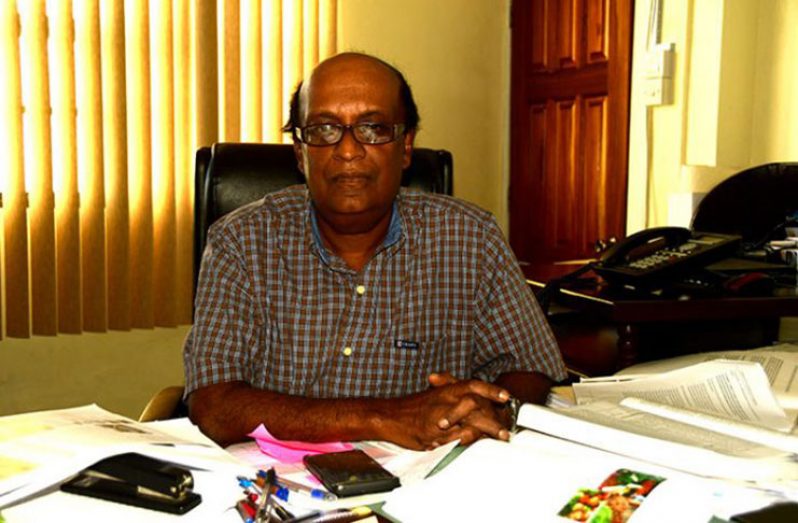-COVID-19 situation reveals Guyana’s potential to serve more markets
CLASPING your hands and closing your eyes before a meal is a simple show of appreciation for “food on your plate,” something which is not readily available to thousands of persons across the world, who are impoverished or might just not have access to food because of prevailing circumstances, such as the novel COVID-19 pandemic.
While there is no evidence to show that every Guyanese is exempted from this fate, there is substantial evidence to show that the nation is “food-secure,” especially at a time when the local economy, like many others, has taken a hit from external and internal shocks caused by the COVID-19 pandemic.
The World Food Programme (WFP) says people are considered food-secure when they have adequate access at all times to sufficient, safe, nutritious food to maintain a healthy and active life. It also lists “food availability,” “food access” and “food utilisation” as pivotal, central planks of food security.
And according to an article from the New York Post, the coronavirus pandemic has brought hunger to millions of people around the world. The report stated that national lockdowns and social-distancing measures are drying up work and incomes, and are likely to disrupt agricultural production and supply routes, leaving millions to worry about how they will get enough to eat.
In listing some examples of this phenomenon, the New York Post said in the largest slum in Kenya’s capital, people desperate to eat set off a stampede during a recent giveaway of flour and cooking oil, leaving scores injured and two people dead.
Additionally, in India, thousands of workers are lining up twice a day for bread and fried vegetables to keep hunger at bay. And across Colombia– Guyana’s South American counterpart–poor households are hanging red clothing and flags from their windows and balconies as a sign that they are hungry. The New York Post said experts have determined that the world has never faced a hunger emergency like this.
Guyanese will not go hungry
Guyana, however, continues to stay “above water” in this regard, and in putting Guyana’s situation in simple terms, Director of the National Agricultural Research and Extension institute (NAREI), Dr. Odhu Homenauth said: “Guyanese will not go hungry.”
The country, he said, is food-secure and will be able to “weather the storm,” because there has been no evident drop in the production of fruits and vegetables.
NAREI has been monitoring the local production of vegetables and fruits and according to Dr. Homenauth, to this end, there has been no decline. For the first quarter of the year (January to March), production was over 179,000 tonnes, compared to 170,000 tonnes in the first quarter of 2019. “Apart from COVID-19, we had dry conditions which may have affected crops, so we saw a slight decrease in terms of acreage of some commodities. The decrease in acreage continues to be a trend,” said the director.
Despite this prevailing trend, Dr. Homenauth said no sector has been hard-hit, but there has been an inevitable decrease in the exportation of some commodities. There has been a reduction in air cargo, especially to Canada and the United States of America because of the restriction on air travel. “Export, [sic] however, continues within the CARICOM region…things like pumpkin, watermelon and eddoes are going by sea…the local processors also continue to absorb various produce, so there is no surplus,” said the director.
NEW PROGRAMME
Although production remains stable, the Ministry of Agriculture has been considering the implementation of a programme which will assist farmers who are suffering from a shortage of disposable income and supplies to cultivate their crops.
Dr. Homenauth said the programme is still being tweaked, but the existing advice to farmers, is to produce commodities that are being utilised right now. Some of those commodities include cherries and passion fruit, which are being used by local processors and even individuals, who are building their immune system with Vitamin C, to fight off the COVID-19.
Considering that Guyana is able to produce commodities to the extent that there is room for a conscious reduction, it is evident that irrespective of the country’s new oil and gas sector, which has been drawing lots of attention, agriculture will continue to be the dominant sector.
“We are food-secure and we need to continue and even expand further…the situation even shows that Guyana has the potential to tap new markets, especially in the CARICOM region,” said Dr. Homenauth.
For years, Guyana, which has an import bill of about US$250 million (past reports), has been importing items such as corn, soy beans, potatoes, wheat, onions, garlic, milk and milk products, and even spices. These products, along with canned items, have contributed to the exorbitant food import bill.
The issue of a large food-import bill is not specific to Guyana, since it was reported that the yearly cost of bringing in food to the Caribbean remain anchored at US$4 billion.
In July 2019, it was reported that with the aim of exiting the high bracket, NAREI had started to explore the possibility of producing commodities such as corn and soy bean, specifically for the livestock feed industry, which expends in excess of US$20 million on imports.



.jpg)










